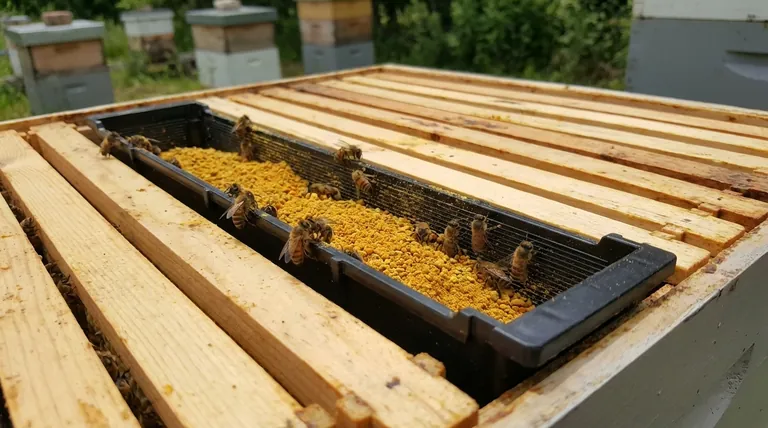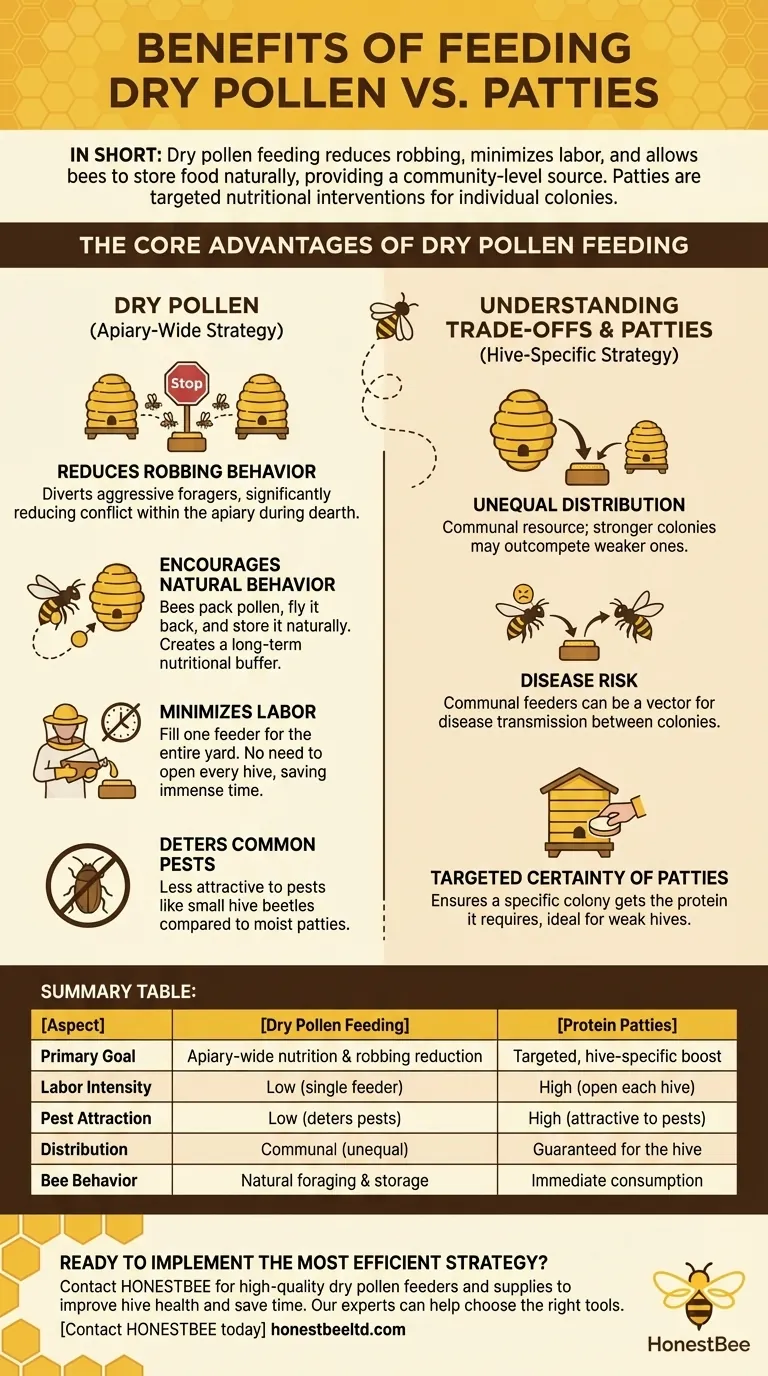In short, feeding dry pollen is primarily beneficial for reducing robbing behavior, minimizing your labor, and allowing bees to store food naturally. It provides a community-level food source that distracts foragers from weaker hives, especially during late-season dearth, and requires less hands-on management than applying individual protein patties.
The choice between dry pollen and patties is not about which is superior, but about your specific goal. Dry pollen feeding simulates a natural pollen flow for the entire apiary, while patties are a targeted nutritional intervention for individual colonies.

The Core Advantages of Dry Pollen Feeding
The decision to use a dry pollen feeder is a strategic one that influences bee behavior and reduces your workload. It is most effective when you need to provide a general food source to an entire yard of bees.
Reduces Foraging Pressure and Robbing
During a nectar or pollen dearth, strong colonies may try to rob the resources of weaker ones. This behavior can quickly destroy a struggling hive.
A dry pollen feeder acts as a powerful distraction. By providing an easy, accessible protein source, it diverts aggressive foragers away from their neighbors, significantly reducing the pressure and conflict within the apiary.
Encourages Natural Behavior and Storage
When bees collect from a dry feeder, they must pack the pollen into their pollen baskets, fly it back to the hive, and store it in cells around the brood nest. This process perfectly mimics their natural foraging behavior.
Unlike patties, which are consumed immediately, this natural storage allows the colony to create a reserve of protein that it can use as needed, providing a more stable and long-term nutritional buffer.
Minimizes Beekeeper Labor and Hive Disruption
One of the most practical benefits is the immense saving in time and effort. Preparing and placing protein patties requires opening every single hive, which is disruptive to the bees and labor-intensive for you.
With a dry feeder, you simply fill a single container for the entire apiary. Replenishing it is quick and does not require disturbing any of the colonies.
Deters Common Pests
Moist protein patties can be highly attractive to pests, particularly small hive beetles, which thrive on the sugary, protein-rich substance.
Dry pollen or pollen substitute is significantly less appealing to these pests, reducing the risk of creating a new problem while trying to solve a nutritional one.
Understanding the Trade-offs: Dry Pollen vs. Patties
While dry feeding has clear benefits, it is not a direct replacement for patties. Understanding its limitations is crucial for responsible hive management.
The Problem of Unequal Distribution
A communal dry feeder operates on a first-come, first-served basis. Stronger, more populous colonies will naturally gather more resources, while weaker hives may still be outcompeted.
If your goal is to save a specific weak colony, a dry feeder offers no guarantee that the colony in most need will get an adequate share.
The Risk of Disease Transmission
Any communal resource, including a feeder, can become a vector for disease transmission between colonies. If one hive is carrying a pathogen, bees can spread it to others at the feeder.
This risk is lower with patties, as they are contained within a single hive, isolating the feeding to one colony.
The Targeted Certainty of Patties
Protein patties are a targeted intervention. They are the right tool when you know a specific colony is light on stores, is building up for pollination, or needs a boost to raise brood.
Placing a patty directly on the top bars ensures that a particular colony gets the protein it requires, making it the superior choice for prescriptive, hive-specific feeding.
Making the Right Choice for Your Apiary
Ultimately, your choice should be dictated by your specific objective. Neither method is universally better; they are tools for different jobs.
- If your primary focus is reducing fall robbing and providing a general supplement: Dry pollen is an excellent, low-effort option that mimics natural foraging and keeps bees busy.
- If your primary focus is boosting a specific weak or growing colony: A protein patty placed directly in the hive is the only way to guarantee that colony receives the nutrition it needs.
- If your primary focus is preventing pest infestations: Dry pollen is less attractive to small hive beetles and other pests compared to moist patties.
By understanding the distinct purpose of each method, you can make the most effective decision for the health of your bees and the efficiency of your management.
Summary Table:
| Aspect | Dry Pollen Feeding | Protein Patties |
|---|---|---|
| Primary Goal | Apiary-wide nutrition & robbing reduction | Targeted, hive-specific nutritional boost |
| Labor Intensity | Low (single feeder for entire yard) | High (open each hive to apply) |
| Pest Attraction | Low (deters small hive beetles) | High (attractive to pests) |
| Distribution | Communal (strong hives may get more) | Guaranteed for the specific hive |
| Bee Behavior | Encourages natural foraging & storage | Immediate consumption |
Ready to implement the most efficient feeding strategy for your operation?
As a trusted wholesale supplier to commercial apiaries and beekeeping equipment distributors, HONESTBEE provides the high-quality dry pollen feeders and supplies you need to save time and improve hive health. Our experts can help you choose the right tools for your specific goals.
Contact HONESTBEE today to discuss your needs and streamline your beekeeping management!
Visual Guide

Related Products
- Professional In-Hive Bee Feeder HONESTBEE Frame for Beekeeping
- Professional Spring-Action Queen Catcher Clip
- Yellow Plastic Bucket Pail Perch for Beekeeping
- Cotton Beekeeping Suit and Round Hat with Veil Bee Keeper Protective Gear
- Heavy-Duty Stainless Steel Clip-On Frame Perch
People Also Ask
- Are frame feeders good? Maximize Your Hive's Health with the Right Feeding Strategy
- What are the two most popular types of honey bee feeders? A Guide to Frame and Bucket Feeders
- How do you feed bees outside the hive? Understanding the Risks and Safe Alternatives
- What are the standard dimensions for Langstroth beehive frames? Choose the Right Size for Your Apiary
- How do I keep bees from drowning in my frame feeder? Essential Tips for a Safe Hive



















